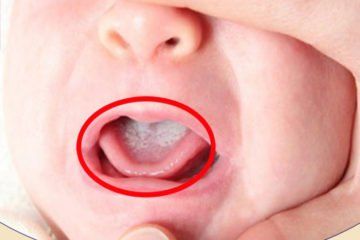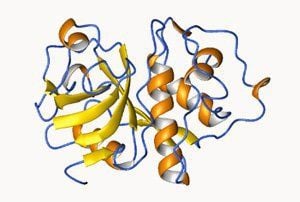This is an automatically translated article.
Children's digestive system consists of many organs that work together to metabolize food/liquids when they eat and drink, which plays an important role in a child's growth. The digestive system structure in children has many differences compared to adults, so understanding these characteristics will help you better manage your child's digestive problems.
The digestive system in general consists of 6 main organs: mouth, esophagus, stomach, intestines, liver and pancreas. Food will begin to go from the mouth to the esophagus, then to the rest of the organs to be metabolized and absorbed by the body.
The structure of the digestive system in children also includes the above organs. However, unlike adults, the digestive system in children is still in the developmental stage and tends to be small and poorly functioning.
1. Mouth/parts in the oral cavity
1.1 Oral cavity and oral mucosa
The oral cavity of breastfed infants is relatively small because of the following characteristics:
The upper jaw bone is underdeveloped; The gum area has many wrinkles; Your baby's lip and masticatory muscles tend to be active; Tongue thick, wide, with many tongue spines and cysts. These factors play an important role in breastfeeding: when the baby suckles, the oral cavity and tongue act like a plunger to draw as much milk as possible.
Children's oral mucosa is relatively thin and soft, with many capillaries, but quite dry. Therefore, in children, it is easy to develop the fungus Candida Albicans that causes thrush.
For infants, along the 2 sides of the midline of the palate you may find white or pale yellow, irritating, green pea-like particles that are hard. These granules are called the Bonneur ganglion, an area of fluid or shedding cells in the gland. These nodes will disappear on their own within a few weeks.

Trẻ em rất dễ bị tưa miệng do niêm mạc miệng mỏng và khô
1.2 Children's salivary glands
Salivary glands in infants are usually in an embryonic state during the first months of life. By about 3 - 4 months, the salivary glands are fully developed. This is the cause of dry oral mucosa in children.
On average, saliva in children is usually neutral or mildly acidic with a pH between 6 and 7.8. For adults, the pH of saliva is higher: from 7.4 to 8. The activity of enzymes such as amylase in saliva also increases with age.
1.3 When do children's teeth form?
Usually, babies between 4 and 6 months old often have salivation. This phenomenon is caused by the stimulation of the tooth germ to the Vth nerve, leading to an enhanced salivary reflex. Another reason is that the child does not know how to swallow saliva.
Children under 6 months do not have teeth and the first baby teeth will start to come in from 6 months and up. The process of fully erupting baby teeth can last until the child is 24 months - 30 months (20 baby teeth full).
When children start 6 years old, children replace baby teeth: baby teeth will begin to fall out and be replaced by permanent teeth. This entire process can be of varying lengths and lengths depending on the child.

Thông thường, trẻ bắt đầu mọc răng sữa từ 6 tháng tuổi trở lên
2. Esophagus in children
The features of the esophagus are one of the typical features of the children's digestive system because this organ has a clear change with each age.
In general, the esophagus in children has the following properties:
The wall and lining of the esophagus are thin. The mucosa has many blood vessels but little glandular organization. Underdeveloped muscles. In terms of length, depending on age, the esophagus has different lengths. As follows:
In terms of diameter, the esophagus changes with age as follows:
Determining the length as well as the diameter of the esophagus according to age will help in choosing the right nasogastric tube.
3. Stomach – a structural feature of the digestive system in children that cannot be ignored
The shape of the stomach changes gradually as the child grows: the stomach in infants is usually round. When a child is 1 year old, the stomach will be more elongated and after 7 years old, the stomach will have the same shape as an adult.
In infants aged 0 to 12 months, the baby's stomach is horizontal and this will last until the child is 7 years old. At this age, the stomach will begin to move into a standing position similar to that of an adult.
The activity of the stomach muscles of young children is relatively weak, especially in the cardiac sphincter. However, the child's pyloric sphincter is well developed and tightly closed. This incoordination causes the child to vomit after eating.
About stomach capacity:
The stomach in infants has a capacity of 30-35ml. Stomach in 3 months old baby: 100ml. Stomach in 1 year old children: 250ml. Children's gastric juice includes enzymes Pepsin, Labferment, Catesin, Lipase to help children digest nutrients from the outside.
The time the food stays in the stomach of a child depends on the nature of the food that the child eats:
Breast milk: from 2 to 3 hours. Cow's milk: from 3 to 4 hours. Fatty foods can stay in the stomach for a long time depending on the activity of the stomach. Therefore, experts often recommend that mothers should arrange meals / milk feedings at least 3 hours apart.

Hình ảnh dung tích dạ dày của trẻ
4. What are the characteristics of children's intestines?
The gut is also a digestive system feature that sets children apart from adults.4.1 Length of intestine
Children's intestines are usually 6 times their body length. Meanwhile, in adults, the length of the intestine is only 4 times. For children who are malnourished - rickets or have persistent diarrhea , the intestines will be longer.
The intestinal mucosa has many hairs and wrinkles, many blood vessels. These properties facilitate the absorption of nutrients. However, this is also a favorable environment for bacteria to invade and grow.
4.2 Activities of enzymes in intestinal fluid
The intestine includes the activity of many different enzymes such as:
Trypsin Enterokinase and Erepsin: Protein digestion. Lipase: fat metabolism. Mantase, Lactase and Invectin: digesting glucid.

Enzyme Lipase trong dịch ruột có chức năng chuyển hóa mỡ
4.3 Intestinal microbiota in children
Gut bacteria play an important role in the digestive process of children as well as ensuring overall health.
Within 8 hours of birth, a baby's stomach and intestines are mostly sterile. After this time, bacteria will begin to enter the baby's digestive system through the mouth, respiratory tract and rectum. These bacteria include staphylococcus, pneumococcus, enterococci, bifidus bacillus, acidophilus bacillus...
On the 3rd day, bacteria will have strong growth. Depending on the child's diet, there will be different levels of beneficial or harmful bacteria:
Breastfed babies: Bifidus bacteria will prevail, inhibiting the activity of E.coli. Babies drink formula: E.Coli develops, leading to diarrhea, digestive disorders. The beneficial bacteria in the gut also have other effects such as synthesizing vitamin K, vitamin B and enhancing the digestion of protein, fat, and starch...

Các loại vi khuẩn sẽ xâm nhập hệ vi khuẩn đường ruột ở trẻ em qua đường miệng
5. Pancreas in children
The pancreas in children often changes shape and weight with age
Pancreas has 2 main functions:
Endocrine function: producing insulin, transporting glucose from the blood into cells. Exocrine function: secrete enzymes such as Trypsin, Lipase, Amylase, Maltase... to help children metabolize nutrients.
6. Characteristics of the liver in children
Newborn's liver is large, accounting for 4.4% of body weight. Here are some key features to look out for in a baby's liver:
The left lobe of the newborn's liver is larger than the right lobe. However, the right lobe has a higher growth rate, so it will grow larger than the left lobe. Children's liver is easily displaced if there is a tumor or pleural fluid. The liver organization has many blood vessels, many cavities, and the cells are not fully developed. Poor liver function, easy irritation when children have infections, poisoning and liver in children are also prone to fatty degeneration. In general, the digestive system characteristics of children have many differences compared to adults. Knowing these characteristics will help parents easily arrange appropriate nutrition as well as detect abnormal digestive problems in children early.
In order to protect the baby's health comprehensively, parents should have their children go for regular general health check-ups to detect health problems of the baby early, from which there are directions for early intervention and treatment.
Currently, Vinmec International General Hospital offers customers a General Health Checkup Package for children. The baby will be thoroughly examined, from eyes, teeth, blood pressure, weight to necessary tests, combined with diagnostic imaging. The examination package helps you check your baby's overall health, screen for symptoms for early detection and treatment if needed.
To register for an examination at Vinmec International General Hospital, you can contact the nationwide Vinmec Health System Hotline, or register online HERE.













